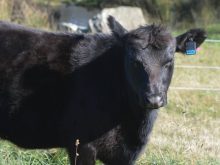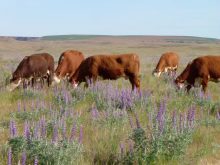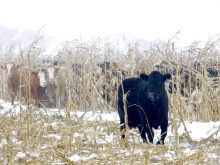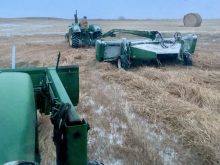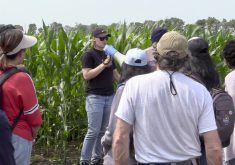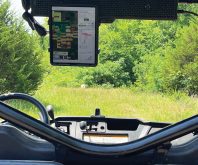The cattle managers at the Copperfield Hutterite Colony near Vauxhall, Alta., northeast of Lethbridge, are using livestock to improve soils and pastures. Phil Hofer and the boys in charge of the cattle are using them in a year-round grazing system that includes intensive pasture rotations on swathed cover crops.
“I am thankful to the management at Copperfield Farms for their support in making this change in our cattle operation,” Hofer says. “What got us started into swath grazing and feeding cattle differently was the fact we were tired of putting up hay all summer, turning around and feeding it to them all winter. We’d just be finishing our haying and cropping season and a month later had to start hauling it all back out again! It was tiring; we didn’t want to feed cattle anymore. More importantly, there wasn’t much profit left with a six-month-long winter,” he says.
Read Also

Harvest wraps up and fall work begins
At the Eppich famly ranch in western Saskatchewan, the fall harvest was successful with few breakdowns, cows and calves have been sorted and a new tractor has arrived
Hofer says while he isn’t an expert on production costs, he trusts the Alberta Agriculture website for providing a reliable indication of feeding costs.
“I’ve looked at the Alberta government’s agricultural website for figures from earlier years, that listed the average cost at $3.75 per day per cow over the winter,” he says. “I assume it’s quite a bit more this year, with the drought. And hay is likely even more expensive — if you can even find any.
“With the old system, it appeared any profit was going into feeding cows, and now we rely more on seeding forages for swath grazing, planting them in late spring and early summer.”
The seed blend is not the same every year and there is no set recipe for a mix that works best. “We are trying different things to see what might work on our place,” Hofer says.

“If we don’t get midsummer rains, we have irrigation to help us along. This is a huge advantage when growing crops for swath grazing. Our fields are all under irrigation pivots. Giving the crops half an inch of water every six days throughout July and August makes all the difference. In our area we don’t get much rain at all, that time of year.”
More tons, less work
The colony is now taking off more tons of forage per acre with cover crops and swath grazing than with three cuttings of hay. The cattle are harvesting the feed themselves — it only has to be put into a windrow instead of being cut, baled, hauled, stacked and hauled out again.
“It takes me 20 minutes to feed 300 cows, just moving a small piece of electric fence every day,” Hofer says. “When it’s 30 below zero, that’s about the time it takes to warm up the feed truck before you can even start feeding! It also takes a lot of fuel to run the trucks and equipment. The swath grazing makes it fun to feed cattle again.”
After combining peas at the end of last July he went into those fields right after to seed brassicas and barley for fall grazing. “We had an excellent fall for raising a good cover crop to run the cows on,” Hofer says.
The manure from grazing cattle adds a lot of fertility and this spring they plan to soil-test those acres to see if there are sufficient nutrients to make it possible to cut back on expensive fertilizer.
Double-cropping options
“We still have a lot of learning to do regarding cover cropping, but are willing to learn and try different things since we don’t have the big expense of wintering cattle anymore,” Hofer says. “Next year we are thinking about double cropping.”
The crop grown for swath grazing is seeded about the first of June, which means there is nothing growing on those fields for about six weeks from early spring until June 1.
“So for next year we’re planning, perhaps in late April, to seed oats and forage peas or other crop that will come up quickly,” Hofer says. “We have a couple options on how to manage the first crop. We could put it up as haylage or let it cure for green feed and sell it. Once the first crop is harvested, then by early June we can seed our swath-grazing crop, which would be ready for swathing at the end of September. We could take off a quick cash crop and then do swath grazing.”

For the winter feeding program, cattle now graze on those swathed-crop windrows right up until calving in March. Hofer says if the weather is nice the cows stay right there, and start calving on those fields.
“If the weather is unfavourable we pull them off and bring the cows closer to home where they can be more easily monitored and have shelter if necessary,” he says. “But as soon as the calves are up and around the pairs go back to the swath grazing to clean it up.” Later they will be moved to different pastures for breeding.
Healthier calves
Hofer says it appears cattle that stay out on the swath grazing to calve seem to be in better shape than the ones fed hay and brought in to calve, and the calves born out on the swaths just seem more healthy and vigorous.
While snowfall can be unpredictable in this part of southern Alberta, cattle can swath graze under most conditions.
“Last year in late November we got a lot of snow,” Hofer says. “It was a storm to remember. We thought the snow was here to stay, but a couple weeks later it was all gone and the cattle had no trouble grazing. With swath grazing, the cattle can easily handle up to two feet of snow.”
The swather takes 30 feet of forage and puts it into a long pile. Instead of rooting around over 30 feet to find feed, the cows just have to find the windrow.
When swathing the field the next year, they adjust their GPS guidance system on the swather by 15 feet so new windrow lays in a different part of the field than the previous year. This means the litter and manure from the swath grazing will be concentrated in a slightly different area of the field each year, providing more complete coverage over the field, which all helps to improve soil fertility.
“The thing about all this is that it’s nothing new,” Hofer says. “We are just rediscovering some things that farmers did a long time ago.” Copperfield colony may eventually include different crops in the program, but currently they continue to experiment with double cropping, taking off the peas as an early crop and then growing the cover crop to be cut for swath grazing.
Their cow herd is mostly straight Black Angus bred to Charolais bulls to produce calves to sell. These crossbred calves grow fast and can be sold in the fall right off the cows, and the market is usually quite strong for these Angus-Charolais cross calves. This is a terminal cross however, none of those heifer calves are kept.
“We have a smaller, separate herd of Angus for raising our replacement heifers,” Hofer says.
While heavier steer calves are marketed early, the younger, lighter calves and replacement heifers are kept through the next winter and fed in a pen.
“Wintering those calves on swath grazing is an option we want to explore. They want to try some new seed blends with a little more energy and higher-quality nutrition for those younger animals.
“If our cattle can graze through the winter, it is an excellent way to cheapen up feeding costs and improve profits,” Hofer says. “We can’t control the markets for our cattle so we have to reduce the costs of feeding them, and help our bottom line. Cattle are supposed to work for us and not the other way around!”



